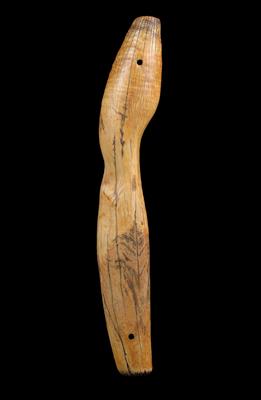Kuba, Dem. Rep. of Congo: An old pestle made of ivory.

An ivory pestle, used by the women of all Kuba tribes in central Congo for grinding cereals and spices. This item displays a beautiful, age-related honey-coloured to dark patina. According to William Fagg, women of well-to-do Kuba families used to receive these ivory pestles for their wedding and used them for the rest of their life. The present ivory pestle is pierced twice and has a special feature: Letters (‘O. A. L.’, almost illegible) and four numbers (‘4’, and ‘878’ below) are stamped or burnt onto the side. These inscriptions are manifestly of European origin. According to Marc L. Felix (Brussels), Belgian missionaries of the ‘Josephite Fathers’ were active in Congo from the 1930s onwards. Besides the missionary activities, they also collected interesting items for the cultural history of Congo, providing all the pieces of the collection with an inventory number. In Europe, the ‘Josephite Fathers’ preserved and displayed their collections in two museums: in Melle near Ghent and in Blankenberge on the North Sea coast. Both museums were closed and their collections sold. Since then, objects with the typical, stamped inventory number of the ‘Josephite missionaries’ have appeared on the art market time and again. One of them is the present ivory pestle of the Kuba people from Congo, with its impressive old usage patina. Between the 19th century and the first third of the 20th century; L.: 70 cm. (ME) ASA
Provenance: Collection of Prof. Rudolf Leopold, Vienna.
Specialist: Erwin Melchardt
 Erwin Melchardt
Erwin Melchardt
+43-1-515 60-465
erwin.melchardt@dorotheum.at
24.03.2014 - 16:00
- Realized price: **
-
EUR 1,250.-
- Estimate:
-
EUR 1,600.- to EUR 2,000.-
Kuba, Dem. Rep. of Congo: An old pestle made of ivory.
An ivory pestle, used by the women of all Kuba tribes in central Congo for grinding cereals and spices. This item displays a beautiful, age-related honey-coloured to dark patina. According to William Fagg, women of well-to-do Kuba families used to receive these ivory pestles for their wedding and used them for the rest of their life. The present ivory pestle is pierced twice and has a special feature: Letters (‘O. A. L.’, almost illegible) and four numbers (‘4’, and ‘878’ below) are stamped or burnt onto the side. These inscriptions are manifestly of European origin. According to Marc L. Felix (Brussels), Belgian missionaries of the ‘Josephite Fathers’ were active in Congo from the 1930s onwards. Besides the missionary activities, they also collected interesting items for the cultural history of Congo, providing all the pieces of the collection with an inventory number. In Europe, the ‘Josephite Fathers’ preserved and displayed their collections in two museums: in Melle near Ghent and in Blankenberge on the North Sea coast. Both museums were closed and their collections sold. Since then, objects with the typical, stamped inventory number of the ‘Josephite missionaries’ have appeared on the art market time and again. One of them is the present ivory pestle of the Kuba people from Congo, with its impressive old usage patina. Between the 19th century and the first third of the 20th century; L.: 70 cm. (ME) ASA
Provenance: Collection of Prof. Rudolf Leopold, Vienna.
Specialist: Erwin Melchardt
 Erwin Melchardt
Erwin Melchardt
+43-1-515 60-465
erwin.melchardt@dorotheum.at
|
Buyers hotline
Mon.-Fri.: 10.00am - 5.00pm
kundendienst@dorotheum.at +43 1 515 60 200 |
| Auction: | Tribal Art |
| Auction type: | Saleroom auction |
| Date: | 24.03.2014 - 16:00 |
| Location: | Vienna | Palais Dorotheum |
| Exhibition: | 18.03. - 24.03.2014 |
** Purchase price incl. buyer's premium and VAT
It is not possible to turn in online buying orders anymore. The auction is in preparation or has been executed already.
